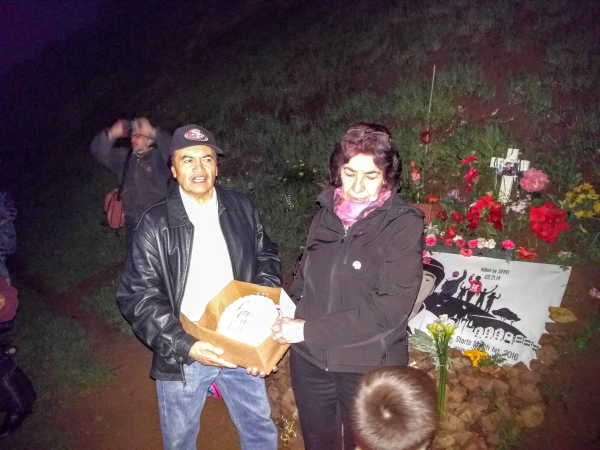Just before U.S. Magistrate Judge Nathanael Cousins entered the courtroom this morning, Alex Nieto’s parents took their seats carrying a solemn pink helium balloon, reading: “Feliz Cumpleanos.” Today would have been their son’s 30th birthday.

Star witness Antonio Theodore, a singer and songwriter with the band Afrolicious, took the stand to begin the fourth day of the federal civil action for the wrongful death and civil rights violations in the death of Alex in a hail of police gunfire.
Yesterday, Theodore’s testimony directly contradicted what we were told by the San Francisco Police officers earlier in the week. Theodore explained that Nieto was no threat, did not take his hands from his pocket nor did he aim the Taser he kept in his holster at the officers.
This morning, Deputy City Attorney Margaret Baumgartner set out to cast doubt on Theodore’s reliability as a witness. The defense asked no questions pertaining directly to his eyewitness testimony of the day Alex Nieto was shot, and Theodore never change his story. Instead, Baumgartner focused entirely on finding irregularities in Theodore’s recollections of events since the shooting and trying to undermine the testimony of someone who had no clear incentive to lie or fabricate anything.
Asked whether he spoke to an investigator from the Nieto family, Theodore said no, at which point Baumgartner read a statement from a deposition, from early 2015, in which Theodore recalled meeting an investigator several times. Theodore strongly affirmed that the only investigator he met was from the city, who served him a subpoena at his home.
Several times during the cross examination, Baumgartner went back and forth on Theodore’s responses from the deposition. “You were badgering me at that time,” he said. “Is your memory about the incidents different now than it was at that time?” asked Baumgartner. “I have become an alcoholic since then, and yea sometimes it helps and sometimes I don’t remember” he said.
But what Theodore does remember and spoke very clearly on again today, was the day of the shooting and what he witnessed.
The city sought to demonstrate that Theodore was biased against law enforcement. Baumgartner continued to ask questions like “so what kind of publications do you read?”, and kept coming back to the fact that although Theodore said he was too afraid to speak to the police, he did speak up about the incident at a gig he was performing at. “A lot of killings were going on at that time and it felt like the right thing to do” he said, after describing how he eventually opened up to a Nieto family member he met at Bernal Heights Park near the memorial.
Help us save local journalism!
Every tax-deductible donation helps us grow to cover the issues that mean the most to our community. Become a 48 Hills Hero and support the only daily progressive news source in the Bay Area.
Nieto’s family lawyer Adante Pointer asked Theodore if he wanted to be in court today “I feel threatened” he said “by standing here in court and making this testimony. I am not for or against anyone. I am doing this for me. I have my own paranoia about this.”
That’s understandable: It’s not an easy decision for an African American male to take a stand against the SFPD. Although the defense made a strong attempt to discredit Theodore’s testimony they asked him no direct questions about the incident itself, nor introduce any evidence that could contradict his testimony. The entire morning effort was to undermine the credibility of the one eyewitness who can contradict the official story.
Next up was the city’s chief medical officer, Dr. Amy Hart. Pointer started questioning by providing details of the gunshot wounds on Nieto’s upper torso; as he asked how the bullet penetrated through the side of his head onto his neck, Elvira Nieto, Alex’s mom, flinched and tears rolled down her eyes.
As both sides geared to ask questions regarding the autopsy and ballistics, Elvira and Refugio Nieto were escorted out of the room, saving them from the trauma of going through the details. The parents had sat through the morning’s proceedings listening intently with the help of a court appointed Spanish translator, but at times they quietly broke into tears when hearing of their son’s last moments.
Adante Pointer, the attorney representing Nieto’s family, painstakingly explained to the jury how a fractured left wrist and bones found in Nieto’s red jacket during the medical examination could be evidence to support the testimony that Nieto had his hands in his pockets during the shooting. He elicited testimony that the position of the bullet wounds to Nieto’s leg would indicate that Nieto was not facing his shooters and firing back and that he would have fallen on the ground after being shot in the shin.
Asked whether the irregularities on Nieto’s jackets were consistent with the injuries on his forearm, Hart responded in the affirmative and said that it was probable that the bone fracture came from the wrist but that she had not tested the bone fragment.
Under cross-examination from Deputy City Attorney Rebecca Bers, Hart maintained that there was no gunpowder residue inside Nieto’s pocket. However, the medical examiner provided no satisfactory response to how the bone fragment could have been found in Nieto’s pocket.
Pointer went on to ask questions about Nieto’s hat, and the coroner noted that brain matter and blood was found in his hat, which is consistent with the evidence that he was likely wearing his hat at the time he was shot. Pointer had raised that issue earlier with Lt. Jason Sawyer, who couldn’t recall several important aspects from the scene, including the fact that Nieto was wearing a hat at the time of the shooting.
Robin Bullard, a resident who was walking his dog in the park, testified that he saw Nieto in the park eating a burrito in what he recounts as “no more than 3 to 4 minutes” before he heard gun shots. Bullard explained Nieto was standing beside one of the benches in Bernal Heights park, looking out over the city wearing a red SF49s jacket, a somewhat common activity for park goers in the neighborhood.
Bullard recounted seeing what he thought was a gun in Nieto’s waistband and continuing on his walk. “He was eating a burrito, I remember noticing his red jacket and thought to myself this guy just bought this jacket it looks very new” he said. It wasn’t until he got within 20 feet of him, that he noticed what appeared to be a gun on his holster.
“I was walking my dog off leash. But I feel this was a key moment , my dog was immediately interested in the smell of the burrito and started walking towards Neito. Had my dog not been so interested in his burrito, I probably would have spoken to him.” he said.
Asked whether he felt Nieto was agitated and if he felt threatened by the gun, the witness said: “He was just sitting there, staring at the city, it’s a scenic spot you can see the Golden Gate Bridge and the Twin Peaks, it’s not unusual,” he said. “I did not feel threatened by the gun, I was just cautious about my dog, and I thought to myself perhaps this guy is a tourist. The vibe I got from him was that he wasn’t alarming.”
In a dramatic reconstruction, Bullard recalled how he came across two Caucasian men who he thought were professional dog walkers and who asked him if he had seen the guy with the gun, “We have called the police,” one of them told Bullard. “I asked them, why? is it illegal to carry a gun in California?” Bullard said, before walking off and thanking the men for being responsible citizens.
Within a few minutes, he said, shots rang out – and at this point, Bullard’s testimony supported that of Theodore’s – and the audio evidence we have obtained. He said he heard a couple of loud shots and then a pause before hearing more shots. At this point, Bullard ran out as far as possible and called 911, “There is a guy up on the hill shooting people” he said. “Of course, at that time I had no idea the police were present, it wasn’t until later that I read and saw what had happened.”
Officer Roger Morse was up next. At the time of the shooting, Morse had been on duty for a little over eight years. Yet, during questioning it was revealed that Morse did not follow standard procedures while handling the situation. California police standards require patrolling police officers to communicate cover-and-contact roles before approaching this type of scene, and asked whether him and his partner had any such communication as they drove down to the area where Nieto was being gunned down, he said, “No we did not.”
Morse denied hearing any pause in the shots, but admitted that by the time he arrived at the scene Nieto was already on the ground. Deespite the fact that Nieto was already on the ground, Morse said he continued shooting until he heard Sawyer say “stop shooting.”
Morse was the first officer to approach Neito after he fell. Asked whether he saw a recoil, or electricity emitting out of the Taser, or anything that looked liked a laser light? Morse responded “No.” He also confirmed that he did not see any Taser wires near Neito.
At the end of the day’s proceedings, the Nieto family and support network made their way back up to Bernal Heights park — the scene of their son’s shooting — to celebrate what would have been his 30th birthday.
During the break, several people approached Refugio and Elvira Nieto, showing their support to the justice for Alex Nieto campaign. “I cannot believe what they have done to your son” a supporter said, with the help of the translator the Nietos’ responded “That is why we are here, it’s a healing process, it is helping us heal and stand up for our son.”



